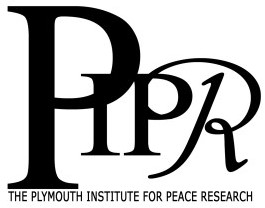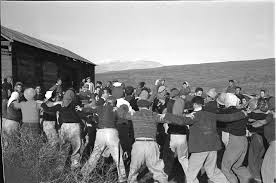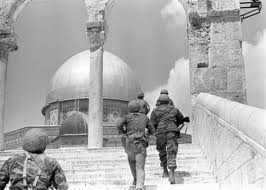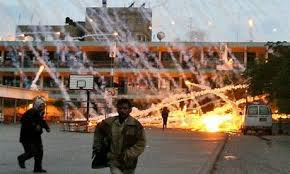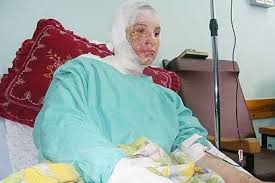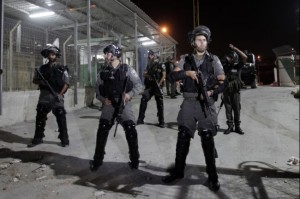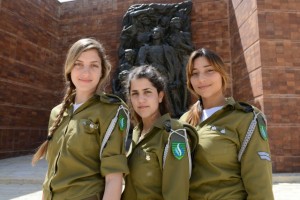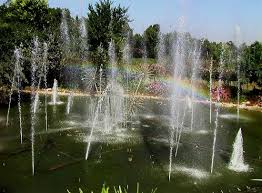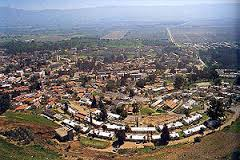The Past is a Moving Target: Author Graham Hurley’s Experiences of Israel and Palestine
By Graham Hurley
1 September, 2014.
Kibbutz Shamir, 1946.
We recently returned from Israel and the West Bank, days before the abduction and killing of the three Israeli teenagers. The last time I went was 48 years ago but even at 19 I was older than the fledgling Israeli state. It was the end of my first year at Cambridge and the long summer vacation yawned ahead. I was as skint as every other student I knew but I badly wanted to put serious distance between myself and the UK and spotted an appeal for fruit pickers on an Israeli kibbutz. In return for a couple of months in the orchards, they gave you a return flight, a bed, free food, and pocket money of (as I recall) a quid a week. Irresistible.
The kibbutz – Shamir – lay at the top of the Hula Valley in the Upper Galilee. The truck that had picked us up at Tel Aviv airport bumped through the orchards and fishponds on the valley floor and then wound up the zigzag road that dead-ended at the kibbutz gate. Shamir, in 1966, crouched beneath the border with Syria. Armed patrols stood guard at night, and during the day – through borrowed binoculars – you could sometimes spot Syrian troops watching us. One of my fellow fruitniks, a blond art student from Geordieland, strayed across the border one afternoon by mistake. She wanted to sketch the kibbutz from above and was surprised to find her view suddenly full of soldiers. Arrested, she was marched away and ended up in a cell in Damascus, charged with being a spy. We never saw her again.
That summer gave me all the insights I thought I’d ever need into the Israeli psyche. With half a dozen other immigrant labourers, I found myself amongst a bunch of sturdy pioneer farmers, most of them from White Russia (today’s eastern bit of Belarus). Every working day started at three in the morning when we mustered in the warm darkness in a patch of dirt behind the dining hall for the truck ride down to the valley floor. At six, a tractor turned up with a canister of thick sweet Arab coffee. We returned to the kibbutz for breakfast before sweating out the rest of the morning on our ladders amongst the trees. By midday, having picked our body weight in apples, we were done.
It was a memorable stay. The kibbutzniks were friendly and the way of life opened doors I never knew existed. A cashless society? Nothing private? Nothing owned? Kids growing up together, sleeping together, eating together, seeing their parents maybe a couple of hours a day? This was the closest I’d ever come to the collective dream, to socialism in the flesh, and it seemed to work. As far as I could judge, people were content. Everyone spoke their mind. Every opinion counted. The food was wonderful – home grown, mega-healthy, beautifully prepared – and there was a brand new swimming pool on the hillside overlooking the valley.
Apple processing, Kibbutz Shamir.
On Thursday nights, there was even a film club. After dinner, as dusk fell, we’d sprawl on the grass in front of an impromptu screen – three sheets stitched together strung from two poles – and watch that week’s offering. Looking back, once I’d adapted to the slow rhythms of kibbutz life, I don’t think I’ve ever been so physically healthy and mentally content. One of my enduring memories was watching The Battleship Potemkin as the pram (and the baby) bumped down the Odessa steps as the wind from the valley rippled across the screen. Unforgettable.
A year later, in May 1967, Nasser closed the Straits of Tiran. With her southern port of Eilat blockaded, Israeli intelligence reported Arab armies massing on every border, determined to drive the Jews into the sea. Prime Minister Eshkol agonised for days about the appropriate response but finally succumbed to the urgings of the Israeli military. The Israeli Air Force struck at first light on the 6th of June, effectively destroying three Arab air forces – Egyptian, Jordanian and Syrian – on the ground. Six days later the war was over and the world awoke to a new player in the Middle East: a much bigger Israel that counted Sinai, Gaza, the West Bank and the Golan Heights amongst the spoils of war. At the time, given the alternative, this appeared to be something of a miracle. Little did we know what was to come.
Like thousands of other students, I volunteered to fight in Israel. On reflection, it was a callow and probably naïve reaction to the drumbeat of media headlines that paved the path to the Six Day War. For one thing, it was hopelessly impractical – what would I have done? – but in the shape of my apple-picking summer at Kibbutz Shamir, I had a tiny stake in this looming catastrophe and it seemed to me, as it seemed to so many others, that simple arithmetic put the moral case beyond dispute. Little Israel was surrounded by trillions of Arabs determined to finish Hitler’s work. Something had to be done.
And so I and my best mate – Steve Brown – hitch-hiked across Europe. We felt martial, armour-clad in our brave young convictions, but by the time we got to Istanbul, the war – rather worryingly – was as good as over. Israeli tanks and infantry were mopping up the spoils of victory and by the time the ferry landed us at Haifa, Israel was a land of celebration. And so we headed north again. To pick more apples.
That long summer, with the giddy realisation that we were part of history in the making, will stay with me forever. Shamir was no longer at the mercy of the Syrian Army. The frontier had been pushed back across the Golan Heights and once Israeli combat engineers had cleared pathways through the minefields above the kibbutz, we could explore what had so recently been enemy territory. An hour’s trek took you to a pool amongst the rocks. The safe paths were marked by lengths of white tape, skittish in the wind, and we carried guns in case of attack by feral dogs, but I’ll never forget the feel and taste of the water in that pool. It was fed from springs deep underground. It was ice cold, welcome balm after the long climb, and it seemed to speak of peace and a kind of deliverance. How wrong I was.
Israeli troops conquering the West Bank, 1967.
Over the decades to come, Israel moved steadily rightwards. The peace treaty of 1979 restored Sinai to the Egyptians but no way were successive governments going to relax the army’s stranglehold on the rest of their winnings. UN resolution 242 demanded a return to pre-war frontiers but occupation of the Golan Heights and the Palestinian West Bank and Gaza kept declared enemies at arm’s length. The Golan Heights was largely depopulated but the West Bank teemed with Palestinian Arabs. Israeli settlements began to appear, along with fine new roads and countless checkpoints. In flagrant contravention of international law, Israel had turned the Palestinian homeland into a giant prison.
By now, of course, I was getting on with my life. I worked in television. I wrote books and TV scripts. I was aware that my hero Israelis had become the snarl on the face of the Middle East but it all seemed a long way away. Memories of Kibbutz Shamir had faded and it was becoming harder and harder to join up the dots.
What did apple-picking have to do with Sharon’s brutal compliance in the massacres of Palestinian refugees in the camps at Sabra and Shatila in Lebanon? How come the guys I’d shared summers with were giving Arab families such a hard time? I had no answers to these questions, and aside from a vague suspicion that history had got the better of me, it was all too easy to park those adolescent memories somewhere safe and get on with the pressures and pleasures of a busy life.
Then, in 2008, Lin and I decided to spend Christmas somewhere warm and interesting. We took a series of trains across Europe and ended up in Istanbul. Christmas Day took us to a café beside the Bosphorus – grilled sardines and chips washed down with serious helpings of Efes lager – and the following week we headed for Syria. As far as the promised warmth was concerned, the Rough Guide turned out to be a dud. It was snowing by the time we got to Damascus and – travelling light – we barely had one pullover between us. I got flu on New Year’s Eve, and stepped groggily into 2009 to learn that the Israelis – once again – were bombarding the Gaza Strip.
Israeli white phosphorus rained on Gaza’s schools and hospitals.
Operation Cast Lead, as they called it, outraged the Syrians. The smell of tear gas badged demo after demo in central Damascus and the Star of David, roughly chalked, began to appear on paving stones on the road to the souk. Helpless in more or less every other respect, angry Arabs made the necessary detour to stamp on the face of Israel.
It was impossible not to ponder what was going on. On the bus into Damascus, I’d noticed the familiar hump of Mount Hermon on the near-horizon. This landmark, one of the biggest mountains in the Middle East, had also loomed over Kibbutz Shamir and all those summers ago I’d always wondered what it looked like from the other side. Now I knew, and that knowledge – coupled with the slaughter of women and kids under a rain of white phosphorus – made me feel deeply uncomfortable.
Back in 1967, in the face of nationwide euphoria, one or two lone voices had warned against what was starting to happen on the West Bank. Wiser statesmen warned that annexation would be unlikely to turn an overwhelming victory into a permanent peace. The theft of land, with all its attendant brutalities, had no place in a decent society. This had cut little ice at the time but nearly fifty years later the real bills for the Six Day War had fallen due. Unthinkably, Israel had become a byword for oppression and many Arabs – angry and helpless – were beginning to talk about ethnic cleansing.
This was no time to be white and Anglo-Saxon in the Middle East. As the Israelis tightened their grip on Gaza, we fled to Jordan – no less hostile – and then took a ferry down the Gulf of Aqaba to the Egyptian port of Nuweiba. This is the Sinai peninsula. The coast stretches north towards Eilat and in January is normally a favourite destination for holidaying Israelis. With Gaza in flames, the usual visitors had wisely decided to stay at home and so the resorts were deserted. We found a grass hut on the beach, swam three times a day, and waited to return to Amman for the flight back home. As the Airbus reached cruising height after take-off, I could see the smoke still rising from the ruins of Gaza.
Ghada Abu Halima (21), died of her injuries from white phosphorus.
That experience found its way into Borrowed Light, the penultimate book in the D/I Joe Faraday series. Faraday, on a birding expedition in Sinai, ends up in hospital in El Arish after a car crash that nearly kills him. He shares the hospital with casualties from nearby Gaza – most of them kids – and what he sees on the wards thickens and deepens a despair that is to have profound implications. I think I understood that despair, and five years later we decided to go back to Israel and see for ourselves what had happened to the Israel of my apple-picking days. It was no coincidence that Borrowed Light was dedicated to Kibbutz Shamir.
A couple of weeks back, we landed at Ben-Gurion Airport at half past one in the morning. The queues for immigration were huge and shuffled very slowly forward. An hour and a half took us steadily closer. The booths were manned by uniformed officers, many of them women. Some of them might have stepped off the cover of a fashion magazine – cool, poised, cold-eyed, dismissively attractive. When you finally made it across the white line, they quizzed you about your background, your plans, and why you had stamps from Syria and Jordan in your passport. They demanded to see hotel bookings, contacts in Israel, and evidence that you had a return ticket. They wanted to know about your itinerary, and why a trip into the West Bank was so important. This is called “profiling” in the trade, and we must have passed muster because we finally got the slip of paper – don’t lose it – that headed us towards the Customs channel and the Greater Israel beyond. As a welcome to the promised land, this struck me as a bit off-message. We need to know about you. We need to be sure you’re not going to hurt us. You’re a stranger here, not a guest. Behave yourself.
Israeli security.
The days to come took us to Jerusalem. We stayed in an apartment, rode the tram, explored the Old City, and did our best to let the place seep into our bones. The Israelis have an astonishing story to tell and a day at the Israeli Museum, and then Yad Vashem, will give you all the clues you need to begin to understand the pickle they’re in. Yad Vashem chronicles the Holocaust. Young Israelis mill around, some bored, some profoundly moved, shuffling slowly en masse from gallery to gallery. This is recent history in the raw, presented with sympathy, anger, sorrow, and what I can only describe as genius. You emerge at the end, confronted with a jaw-dropping view of the Judean Hills, and you understand at a single glance what these people are doing here. Europe made it tough for them. Europe nearly killed them all. And they’re not going to let it happen again.
That, at least, is a step forward. It doesn’t begin to excuse what’s happening in the West Bank and Gaza but at least you start to suss how one nightmare can so easily lead to another. To my knowledge, there weren’t any Arabs at Auschwitz and Treblinka, but – as the Israelis are only too eager to point out – their enemies share the same dream. To get rid of the Jews.
Hence the armed state. Hence the gun-toting soldiers on every bus. Hence the hostile arrogance of the immigration officials. Hence the checkpoints into – and across – the West Bank. Hence the wall that bites into Palestinian land and hands it to the settlers. Israel is more than a fortress. In the most bitter of historical ironies, it’s become a vast ghetto, armed to the teeth, a showpiece democracy in the roughest of neighbourhoods, a still-young nation dedicated to the simplest of propositions: its own survival.
Israeli Occupation Forces reminded of the Holocaust.
The results aren’t pretty. This stuff is all anecdotal but you watch, and you listen, and after a while you conclude that Israelis are uneasy with each other. People – on buses, especially – seem glum and somehow walled-off. They don’t talk much. They rarely laugh. By definition, most of them have come from somewhere else and their defensiveness shows. By every metric – GNP, infrastructure, consumer choice, average earnings – Israel has been a blinding success yet little of this seems to have translated into anything close to happiness. These are deeply intelligent people. Many Israelis still have a profound respect for learning, for reading, for the rabbinical disciplines of the yeshiva. So maybe they understand they’re on the wrong side of history, that force alone can’t protect them against an uncertain future, that one day some form of accommodation will have to be made with their Levantine neighbours, above all with the West Bank Palestinians.
We spent a couple of days on the West Bank. Palestine is a very young society. The birth-rate has become one of Israel’s darker nightmares and there are kids everywhere. After the showpiece developments of Tel Aviv and Netanya, soaring apartment blocks with Mediterranean views, the place has a Third World feel. It’s dirtier, noisier, more chaotic, more human. Israelis warned us against travelling alone yet in the teeming cities of Ramallah and Hebron we never once felt threatened. Ask a stranger the directions to a hotel or where we might find the best café, and he’ll do his best to oblige. And if he can’t speak English, he’ll find someone who does. We happen not to be Jewish but we’re self-evidently white and very definitely come from the West yet none of the burden of recent history seemed to matter. You’re guests in our land. Welcome.
After the glumness and self-absorption of Israel, this came as something of a relief. The average Palestinian might have to survive on a tenth of the Israeli average wage but in ways too subtle to quantify, they seem happier. These people, we thought, have warmth and grace. Their society, despite all the problems it faces, still works. Above all, they know who they are. And – dare I say it – where they ought to belong.
There are more than a hundred Israeli settlements on the West Bank. Illegal under international law, they hog the high crowd, steal the best water, and proclaim the historic right to a land that has belonged to the Arabs for millennia.
Water in Palestine.
We spent one morning in the company of a Palestinian called Hani, who lived in a village near Bethlehem. He took us on a circuitous route to Hebron, passing settlement after settlement. The newest ones are trailer parks. Longer established settlements are a sprawl of pink roofs, heavily guarded. Collectively, they represent a long-term investment in land that isn’t theirs to own.
Water in Israel.
It happened to be Friday, the holiest day of the week for Muslims. The Ibrahimi Mosque lies in the middle of Hebron. As the final resting place of Abraham and his family, it is the third most sacred site in Islam. Israeli settlers have established themselves bang next door – they also believe in the sanctity of the site – but in order to pray in the mosque, Palestinians must pass checkpoint after checkpoint under the cold gaze of heavily-armed Israeli troops, while elderly Jewish couples off the tour bus queue at the souvenir shop next door. Simple tact is one key that might unlock the door to peace. Given Muslim sensitivities about worship, about the importance of their religion, what on earth are the Israelis doing?
It gets worse. The Hebron souk used to be the heart of this city but the central alley is now netted to catch the rotten fruit and heavier items tossed away by Israeli settlers living in the apartments above. Soldiers are everywhere, gazing down from control points. You can taste the tension – the aggression – in the air. And yet the settlement building goes on. Possession, say some, is nine tenths of the law. And here’s the living proof.
Illegal Israeli colonizes look down on Palestinians and treat them like trash–literally.
In our final week, we left the West Bank and headed north, into the Upper Galilee. In a way this is how the journey began, in Kibbutz Shamir. Forty eight years later, I wanted to check it out.
The bus took us to Kiryat Shmona, Israel’s northernmost township. It was bigger than I remembered, and visibly more prosperous, but still a mess. We hired a car and headed across the valley. The weather happened to be misty. Half a lifetime ago, you could see clear across the valley, from Syria to the Lebanon. Not today.
I’d acquired directions to Shamir from the car hire company. Within minutes, we were amongst the lush greenness of the fruit orchards. Memories flooded back. Left here. Then right. Then onto the road that zigzagged up the hillside towards Shamir. Looking back, I could see the dull metallic sheen of the fishponds. Pickled carp, I thought. With yoghurt and dill-flavoured gherkins for breakfast. Then back to the orchards to pick yet more apples.
Kiryat Shmona.
We rounded the last bend. Above us, Shamir seemed to have grown. Then came the guardhouse and the barrier gate. We’d seen the same structures on the West Bank and both seemed new. We pulled into the designated parking zone and got out. Israel is the land of queues. This one had formed in front of the guardhouse.
The woman in charge spoke perfect English. As I later discovered, she’d emigrated from Canada in the seventies and settled here in Shamir. I did my best to explain about my glorious summers down in those same orchards, about the Six Day War, and about my curiosity to see what had happened since, but while she was sympathetic she said there was no chance of getting into the kibbutz itself. Sure, I could drive around the perimeter road, get a feel for the place, but security was tight just now and rules were rules. I tried again, pointed out that I’d flown thousands of miles, got myself in a state of high excitement, promised my wife a peek at my dreams, but she wasn’t having it. The perimeter road. Ten minutes. Max.
And so we drove round. It was evident within seconds that the Shamir I’d known, the ramshackle old kibbutz of my fondest memories, had gone. In its place was a sprawling estate of new-looking houses, of carefully tended gardens, of ticking hoses, of play areas for the kids. A grid of factories occupied an industrial estate and a mountain of shipping containers were awaiting the trucks that would take them to the coast. As the perimeter road looped round the kibbutz, there were even roundabouts.
Israeli children are brainwashed to hate. These girls are writing messages on missiles that will be fired on Lebanon.
Roundabouts? Kibbutz Shamir, the place that had haunted my dreams for so long, the bunch of sturdy pioneers that had taught me so much, had become a corner of Basingstoke: affluent, orderly, and doubtless mega-successful.
We checked some of this out when we returned to the guardhouse. The woman in charge was more than happy to talk. She was able to bridge the years since the late Sixties and she confirmed the evidence of our own eyes. The kibbutz, the way of life I’d known and loved, had gone. The kids no longer grew up together. People drew a wage. They owned their own houses. You had to pay for everything. In other words, after years in the deep space of an ideal made flesh, Kibbutz Shamir had gone for re-entry and was back with the rest of society.
Was that an improvement? Definitely not. Were there things from the old days she missed? Of course. Would she ever consider moving away?She thought about the question for a long moment. Then she shook her head.
“I’m too old”, she said, her eyes straying to the window. Yet another truck was waiting at the gate. She punched the button and raised the barrier. The driver barely spared her a glance.
Graham Hurley is a writer and former documentary-maker. His books include Touching Distance and The Ghosts of 2012.
